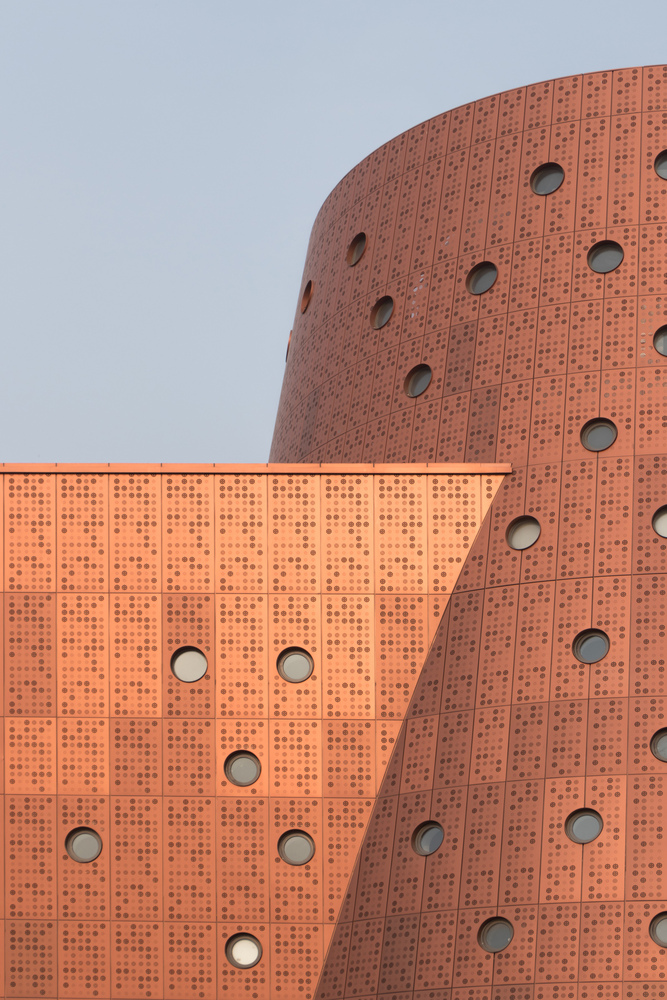Rocha Apartment CaSA
2011-12-12 00:00
架构师提供的文本描述。简单地说,就是把这个被忽视的、分布很差的公寓改造成一个有吸引力的度假之家。酒店位于一条非常中央的街道上,位于加泰罗尼亚广场大学广场之间,位于一座艺术新楼的六楼。尽管如此,这层楼建于60年代,缺乏建筑其余部分的魅力。
Text description provided by the architects. The brief was to transform this neglected, very badly distributed apartment into an attractive holiday home. The property is located in an extremely central street, right between Plaza Catalunya y Plaza Universitat, on the sixth floor of an art nouveau building. Nonetheless, this last floor was built in the ’60 and lacked of the charm of the rest of the building.
为了满足这一要求,必须彻底重新考虑空间,并拆除所有现有的分区。预算紧张,需要巧妙的解决办法来满足需求,提供一种吸引人的、当代的节日氛围。
In order to meet the brief, spaces had to be re-thought completely and all existing partition had to be demolished. The budget was tight and clever solutions were required to complete the needs providing an attractive, contemporary holiday atmosphere.
我们的客户需要四间卧室。四间新浴室已经建成,其中只有一间不是套房。厨房被搬到了宽敞的生活中,腾出空间给一个额外的卧室。
Our client required four bedrooms. Four new bathrooms have been created, of which only one isn’t en-suite. The kitchen has been moved to be part of the wide living and to make space to an extra bedroom.
选择的材料调色板包括一个微水泥浅灰色无光地板,天然木材,和一个不同的颜色为每个浴室,和两个阴影在走廊。其余的都是白色的。
The chosen palette of materials included a micro-cement light grey matt floor, natural timber, and a dash of a different colour for each bathroom, and two shades in the corridor. The rest is white.
白天的区域被完全开放了,包括一个曾经是宽的,半暗的入口空间,以前的布局进入新的明亮的生活区。
The day area was opened up completely by including what used to be a wide, semi-dark entrance space of the previous layout into the new bright living area.
特别注意创造一个新的区域,一个跨越内部和外部的放松区域。多年前关闭的带有屋顶和铝制窗框的露台现在已经恢复、开放并延伸到起居室的内部,将部分室内空间视为室外空间。内部区域被提升到与外部相同的水平。我们使用典型的“拉西拉”陶瓷砖覆盖地板,以及新的砖石座椅折叠周围的放松区。其中一个座位就在窗户下面,允许座位往内或向外看。
Special attention has been given to the creation a new zone, a relax area across interior and exterior. The terrace that had been closed years ago with a roof and aluminium window frames, has now been resumed, opened and extended towards the interior, in the living room, by treating part of the indoor space as outdoor. The inner area has been lifted at the same level as the exterior. We used the typical “rasilla” terracotta tiles to clad the floor as well as the new masonry seats folding all around the relax area. One of these seats is is right below a window, allowing to seat looking inside or outside.
通过将木质石板天篷延伸到正面墙壁上,露台的部分在视觉上延伸到了室内放松区。墙壁也被处理在里面用相同的粗糙的灰泥用于露台墙。
By extending the wooden slats canopy across the facade wall, the portion of the terrace has been visually extended to the indoor relax area. Walls were also treated on the inside with the same rough plaster used for the terrace walls.
在对面,一张酒吧桌从新开的弧形窗口延伸到外面,形成一张室外餐桌。已被砖砌的拱形窗口再次被打开,以插入一个旋转的拱形窗口,使拱门清晰地显现出来。拱形在杆的弯曲轮廓和室外台面的浮雕中重新出现。
On the opposite side, a bar table prolongs on the outside through the newly opened arc window, to form an outdoor dining table. The arched window that had been bricked has been opened again to insert a pivoting arched window that allows the arch to appear clearly. The arched shape reappears in the curved outline of the bar and in the relief given to the outdoor table surface.
白色管道结构是贯穿整个项目的主题之一。它们是用白色的管子和浅色的康柏(Compac)表面设计和定制的,形成了露台和酒吧,以及厨房岛、入口处和所有浴室。厨房岛区允许面向起居室做饭,同样的电火表面继续创造适合六个人的餐桌,由克罗内克的流线型线灯微妙地点亮,悬挂在上面。
The white tubes structures are one of the themes carried through the whole project. They were designed and custom made with white tubes and light coloured Compac surfaces, and form the terrace table and bar, as well as in the kitchen island, the entrance screen, and all the bathrooms. The kitchen island block is intended to allow to cook facing the living area and the same surface of the electric fires continues to create dining table suitable for six people, lit subtly by the streamlined Line lamp by Cronek, hanging above.
厨房的墙壁是用马特白色瓷砖完成的,它也覆盖了厨房计划顶部的架子。这个架子上有一盏灯照亮厨房的工作台。瓷砖墙面和架子都从厨房传递到酒吧,视觉上统一了这两个区域。隔开它们的体积包含一个煤气壁炉。
The kitchen wall is finished in matt white ceramic tiles that also cover the shelf that project on top of the kitchen plan. This shelf carries a light to illuminate the kitchen worktop. Both the tiled wall surface and shelf pass from the kitchen to the bar, unifying visually the two areas. The volume that separates them incorporates a gas fireplace.
一个巨大的木制旋转门旋转,使进入夜间地区。当门被关闭时,墙壁和天花板的茶色出现在木结构上,并穿过用作门把手的白色孔。
A great wooden pivoting door spins to give access to the night area. When the door is closed, the teal colour of the walls and ceiling appears framing the wood and through the white hole used as door handle.
同样的白色管子细节再次出现在走廊壁橱的把手,隐藏洗衣机和家用电器,并再次出现在天花板上的LED聚光灯,由克罗内克。
The same white tube detail reappears in the handles of the corridor closet, hiding the washing machine and house appliances, and again in the led spotlights on the ceiling, by Cronek.
第一间卧室是最小的,没有浴室。但它的两面墙都有从地板到天花板的窗帘。
The First bedroom is the smallest one and does not have a bathroom. But two of its walls have floor-to-ceiling curtains.
公共浴室,铺着蓝色的陶瓷和亮黄色的浆液,打开在一个小的浅井露台上,里面放满了植物,淋浴间有一扇窗户可以俯瞰绿色。
The communal bathroom, tiled with blue ceramics and a bright yellow grout, opens on a small light well patio that’s been retrieved and filled with plants, its shower has a window overlooking the green.
这四间双人卧室很简单,而且几乎是基本的,但很详细。两层从地板到天花板的窗帘软化了覆盖整个公寓地板的淡淡灰色微水泥;这些窗帘不是分散了光线,就是挡住了它。在走廊上涂有茶色色调的凳子用作床头柜。
The four double bedrooms are simple and almost basic, but detailed. Two layers of floor-to-ceiling drapery soften the matt light grey micro-cement that covers the floors of the whole apartment; these curtains either diffuse the light or block it. Stools painted with shades of the teal colour of the corridor are used as bedside tables.
在这三个房间中的两个房间里,浴室打开空间,露出一抹彩色瓷砖,粉红色、黄色或浅绿色,与之形成对比色。
In two of the three rooms the bathrooms open onto the space to reveal a dash of coloured ceramic tiles, pink, yellow or light green, grouted with a contrast colour.
卧室里的淋浴也是开放的,隔开了一个巨大的玻璃隔板。在后两个套间中,洗脸盆安装在专门设计的白色管状结构上,以保持空间畅通。倾斜的正方形镜子可以使人在不遮挡自然光线的情况下进行反射。同样的管子被用来制造毛巾衣架和非常简单的衣架来挂衣服。
Showers are open on the bedrooms too, separated by a great glass partition. In the last two suites the washbasins are mounted on the specially designed white tube structures, in order to leave the space open. The tilted square mirrors allow one to reflect without blocking the natural light. The same tubes are used to create towel hangers and very simple racks to hang the clothes.
在床上和入口处的墙壁上,我们选择了悬挂荷兰艺术家西格丽德·卡龙(SigridCalon)的精美平面作品,这与公寓的语言非常吻合。
On walls above the beds and in the entrance we chose to hang the beautiful graphic work of Dutch artist Sigrid Calon, that matches beautifully the language of the apartment.
客厅的座位和茶几都是由巴塞罗那的家具公司龙虾节(Lobster‘sDay)提供的。放松区的垫子是用日本面料做的,里面有一个拱形图案,可以回忆起窗户、壁龛和外面的穹顶。
Living room seats and tea table are by Barcelona-based furniture firm Lobster’s Day. The relax area’s cushions are made-by-measure with a Japanese fabric featuring an arch motif recalling the window, the niche and the dome on the outside.
 举报
举报
别默默的看了,快登录帮我评论一下吧!:)
注册
登录
更多评论
相关文章
-

描边风设计中,最容易犯的8种问题分析
2018年走过了四分之一,LOGO设计趋势也清晰了LOGO设计
-

描边风设计中,最容易犯的8种问题分析
2018年走过了四分之一,LOGO设计趋势也清晰了LOGO设计
-

描边风设计中,最容易犯的8种问题分析
2018年走过了四分之一,LOGO设计趋势也清晰了LOGO设计












































































































































